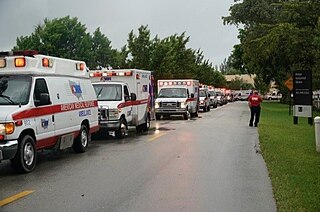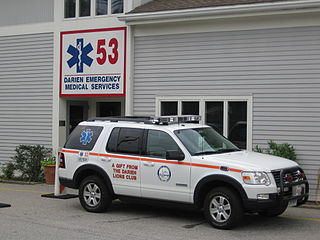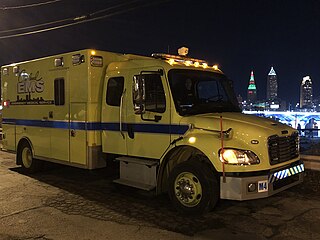Related Research Articles

Emergency medical services (EMS), also known as ambulance services or paramedic services, are emergency services that provide urgent pre-hospital treatment and stabilisation for serious illness and injuries and transport to definitive care. They may also be known as a first aid squad, FAST squad, emergency squad, ambulance squad, ambulance corps, life squad or by other initialisms such as EMAS or EMARS.

An emergency medical technician (EMT), also known as an ambulance technician, is a health professional that provides emergency medical services. EMTs are most commonly found working in ambulances. In English-speaking countries, paramedics are a separate profession that has additional educational requirements, qualifications, and scope of practice.

A paramedic is a registered healthcare professional who works autonomously across a range of health and care settings and may specialise in clinical practice, as well as in education, leadership, and research.
The Seattle & King County Emergency Medical Services System is a fire-based two-tier response system providing prehospital basic and advanced life support services.
A medical director is a physician who provides guidance and leadership on the use of medicine in a healthcare organization. These include the emergency medical services, hospital departments, blood banks, clinical teaching services and others. A medical director devises the protocols and guidelines for the clinical staff and evaluates them while they are in use.

The George Washington University Hospital is a for-profit hospital, located in Washington, D.C. in the United States. It is affiliated with the George Washington University School of Medicine and Health Sciences. The current facility opened on August 23, 2002, with 371 beds in a 400,000 sq ft building, housing more than $45 million of medical equipment and costing over $96 million to construct. The hospital is licensed by the District of Columbia Department of Consumer and Regulatory Affairs and accredited by the U.S. Joint Commission.

The California Emergency Medical Services Authority is an agency of California State government. The California EMS Authority is one of the thirteen departments within the California Health and Human Services Agency. The director is required to be a physician with substantial experience in emergency medicine. Dave Duncan MD is the current Director.
Trauma: Life in the E.R. is a medical-based television reality show that formerly ran on TLC from 1997 to 2002 and reruns are currently airing on Discovery Life. At its peak, Trauma was one of TLC's top-rated shows and spawned two spin-offs, Paramedics and Code Blue. The series itself was nominated for seven Emmys.

In the United States, the paramedic is a professional whose primary focus is to provide advanced emergency medical care for critical and emergency patients who access Emergency Medical Services (EMS). This individual possesses the complex knowledge and skills necessary to provide patient care and transportation. Paramedics function as part of a comprehensive EMS response, under medical oversight. Paramedics perform interventions with the basic and advanced equipment typically found on an ambulance. The paramedic is a link from the scene into the health care system. One of the eligibility requirements for state certification or licensure requires successful completion of a nationally accredited Paramedic program at the certificate or associate degree level. Each state varies in requirements to practice as a paramedic, and not all states require licensure.
The Center for Emergency Medicine of Western Pennsylvania is a multi-hospital consortium based in Pittsburgh, Pennsylvania. It is claimed to be one of the world's premiere centers of Emergency Medicine and EMS development. It currently ranks sixth for residencies in emergency medicine by reputation.

Louisville Metro Emergency Medical Services is the primary provider of pre-hospital life support and emergency care within Louisville-Jefferson County, Kentucky. LMEMS is a governmental department that averages 90,000 calls for service, both emergency and non-emergency, each year.

In the United States, emergency medical services (EMS) provide out-of-hospital acute medical care and/or transport to definitive care for those in need. They are regulated at the most basic level by the National Highway Traffic Safety Administration, which sets the minimum standards that all states' EMS providers must meet, and regulated more strictly by individual state governments, which often require higher standards from the services they oversee.

Emergency medical services in Canada are the responsibility of each Canadian province or territory. The services, including both ambulance and paramedic services, may be provided directly by the province, contracted to a private provider, or delegated to local governments, which may in turn create service delivery arrangements with municipal departments, hospitals or private providers. The approach, and the standards, vary considerably between provinces and territories.
Advanced emergency medical technicians (AEMT) are providers of prehospital emergency medical services in the United States. A transition to this level of training from the emergency medical technician-intermediate (EMT-I), which have somewhat less training, began in 2013 and has been implemented by most states at this point. The AEMT is not intended to deliver definitive medical care in most cases, but rather to augment prehospital critical care and provide rapid on-scene treatment. AEMTs are most usually employed in ambulance services, working in conjunction with EMTs and paramedics, however are also commonly found in fire departments and law enforcement agencies as non-transporting first responders. Ambulances operating at the AEMT level of care are commonplace in rural areas, and occasionally found in larger cities as part of a tiered-response system, but are overall much less common than EMT- and paramedic-level ambulances. The AEMT provides a low-cost, high-benefit option to provide advanced-level care when the paramedic level of care is not feasible. The AEMT is authorized to provide limited advanced life support, which is beyond the scope of an EMT.
In the United States, the licensing of prehospital emergency medical providers (EMTs) and oversight of emergency medical services are governed at the state level. Each state is free to add or subtract levels as each state sees fit. Therefore, due to differing needs and system development paths, the levels, education requirements, and scope of practice of prehospital providers varies from state to state. Even though primary management and regulation of prehospital providers is at the state level, the federal government does have a model scope of practice including minimum skills for EMRs, EMTs, Advanced EMTs and Paramedics set through the National Highway Traffic Safety Administration (NHTSA).

The District of Columbia Fire and Emergency Medical Services Department, established July 1, 1804, provides fire protection and emergency medical service for the District of Columbia, in the United States. An organ of the devolved district government, Fire & EMS is responsible for providing fire suppression, ambulance service and hazardous materials containment for the federal district.

New Orleans Emergency Medical Services is the primary provider of advanced life support emergency medical services to the city of New Orleans, Louisiana, United States. Unlike most other emergency medical services in the United States, New Orleans EMS is not part of the New Orleans Fire Department; rather, New Orleans EMS. is operated by the New Orleans Health Department and the New Orleans Office of Homeland Security and Emergency Preparedness.
The history of the District of Columbia Fire and Emergency Medical Services Department, which grew gradually as volunteer companies formed between 1770 and 1860, then more rapidly with the addition of paid members starting in 1864 and the transition to a fully paid department in 1871, has been marked in recent years by various controversies and scandals.

Nancy Lee Caroline,, was an American physician and writer who worked in emergency medical services (EMS). She was a co-founder of Freedom House, an emergency ambulance service that assisted underserved populations in Pittsburgh in the 1960s and 1970s. She was also the first medical director of Magen David Adom, Israel's Red Cross Society, and was later called by colleagues, "Israel's Mother Teresa".

The City of Cleveland Division of Emergency Medical Service, also known as Cleveland EMS or CEMS, is the division of the municipal government tasked with emergency ambulance transport for the City of Cleveland, Ohio.
References
- ↑ "Female EMS Leader Spotlight: Jullette Saussy, MD". Journal of Emergency Medical Services. Archived from the original on February 16, 2016. Retrieved 2010-03-17.
- ↑ "Audit finds D.C. fire officials failed to implement overhauls after 2006 death".
- ↑ "Jullette Saussy Resignation Letter" . Retrieved 2016-02-09.